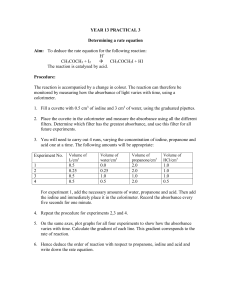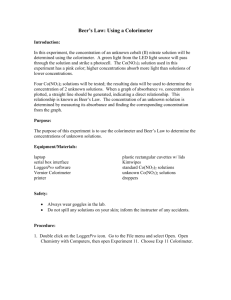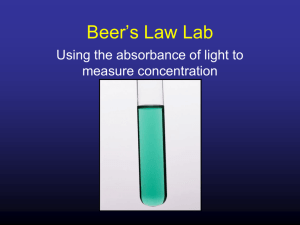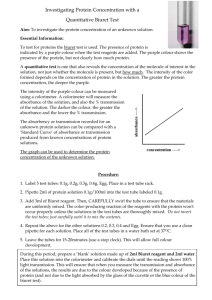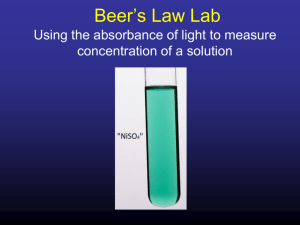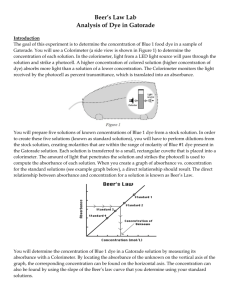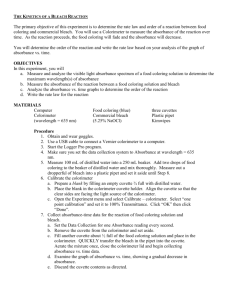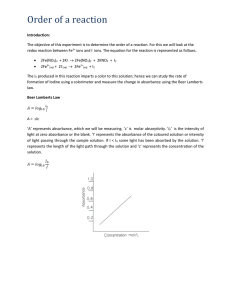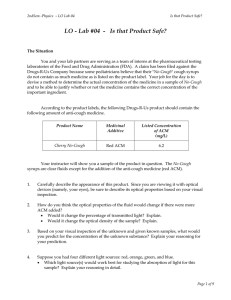BEER’S LAW INVESTIGATION GUIDED INQUIRY VERSION
advertisement
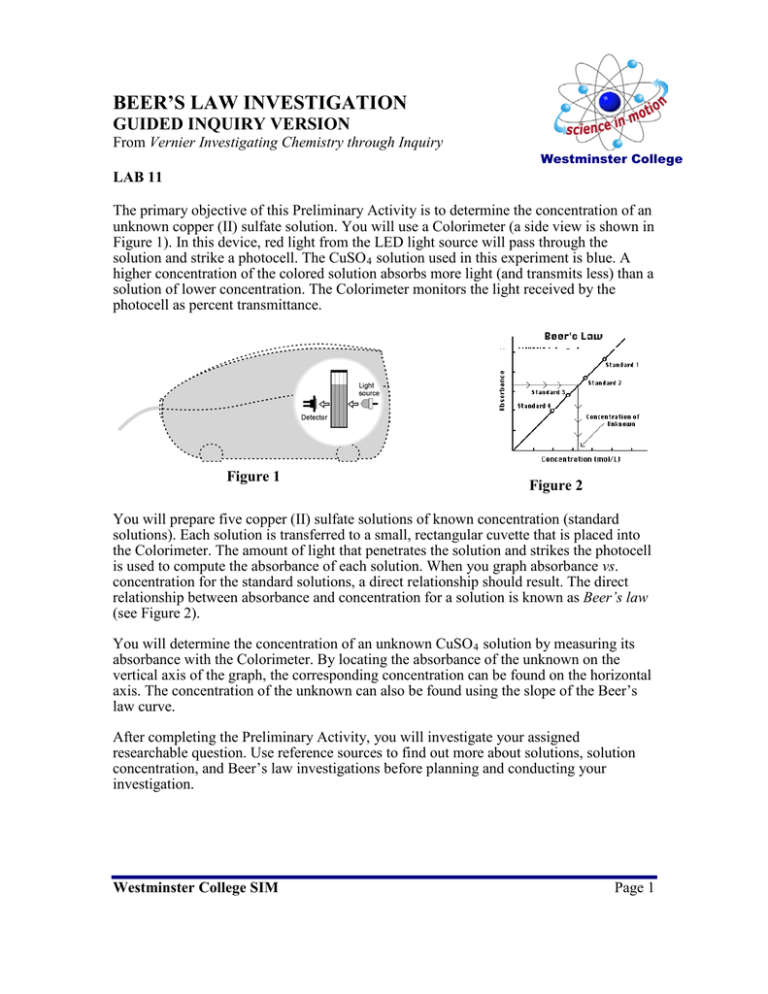
BEER’S LAW INVESTIGATION GUIDED INQUIRY VERSION From Vernier Investigating Chemistry through Inquiry Westminster College LAB 11 The primary objective of this Preliminary Activity is to determine the concentration of an unknown copper (II) sulfate solution. You will use a Colorimeter (a side view is shown in Figure 1). In this device, red light from the LED light source will pass through the solution and strike a photocell. The CuSO 4 solution used in this experiment is blue. A higher concentration of the colored solution absorbs more light (and transmits less) than a solution of lower concentration. The Colorimeter monitors the light received by the photocell as percent transmittance. Figure 1 Figure 2 You will prepare five copper (II) sulfate solutions of known concentration (standard solutions). Each solution is transferred to a small, rectangular cuvette that is placed into the Colorimeter. The amount of light that penetrates the solution and strikes the photocell is used to compute the absorbance of each solution. When you graph absorbance vs. concentration for the standard solutions, a direct relationship should result. The direct relationship between absorbance and concentration for a solution is known as Beer’s law (see Figure 2). You will determine the concentration of an unknown CuSO 4 solution by measuring its absorbance with the Colorimeter. By locating the absorbance of the unknown on the vertical axis of the graph, the corresponding concentration can be found on the horizontal axis. The concentration of the unknown can also be found using the slope of the Beer’s law curve. After completing the Preliminary Activity, you will investigate your assigned researchable question. Use reference sources to find out more about solutions, solution concentration, and Beer’s law investigations before planning and conducting your investigation. Westminster College SIM Page 1 BEER’S LAW – GUIDED INQUIRY VERSION PROCEDURE 1. Obtain and wear goggles. 2. Obtain small volumes of 0.40 M CuSO 4 solution and distilled water in separate beakers. 3. Label five clean, dry, test tubes 1-5. Use pipets to prepare five standard solutions according to the chart below. Thoroughly mix each solution with a stirring rod. Clean and dry the stirring rod between uses. Trial number 0.40 M CuSO 4 (mL) 1 2 3 4 5 2 4 6 8 ~10 Distilled H 2 O (mL) Concentration (M) 8 6 4 2 0 0.080 0.16 0.24 0.32 0.40 4. Set up the data-collection system. a. Connect the Colorimeter to the data-collection interface. b. Start the data-collection program. c. Set up data collection for Events with Entry. The entry name should be “Concentration,” and units should be “mol/L.” 5. Calibrate the Colorimeter. a. Prepare a blank by filling an empty cuvette 3/4 full with distilled water. b. Place the blank in the cuvette slot of the Colorimeter and close the lid. c. Press the < or > buttons on the Colorimeter to set the wavelength to 635 nm (Red). Then calibrate by pressing the CAL button on the Colorimeter. When the LED stops flashing, the calibration is complete. 6. You are now ready to collect absorbance-concentration data for the five standard solutions. a. Start data collection. b. Remove the cuvette from your Colorimeter and pour out the water. Using the solution in Test Tube 1, rinse the cuvette twice with ~1 mL amounts, and then fill it 3/4 full. Wipe the outside with a tissue, place it in the Colorimeter, and close the lid. Westminster College SIM Page 2 BEER’S LAW – GUIDED INQUIRY VERSION c. When the absorbance readings have stabilized, select Keep and enter 0.080 as the concentration. Select OK. The absorbance and concentration values have now been saved for the first solution. d. Discard the cuvette contents as directed. Using the solution in Test Tube 2, rinse the cuvette twice with ~1 mL amounts, and then fill it 3/4 full. Wipe the outside, place it in the Colorimeter, and close the lid. When the absorbance readings have stabilized, select Keep and enter 0.16 as the concentration in mol/L. Select OK. e. Repeat Part d of this step for Test Tube 3 (0.24 M), Test Tube 4 (0.32M), and the stock 0.40 M CuSO 4 . Note: Do not test the unknown solution until Step 7. f. Stop data collection. 7. Determine the absorbance value of the unknown CuSO 4 solution. a. Obtain about 5 mL of the unknown CuSO 4 in another clean, dry, test tube. Record the number of the unknown in your data table. b. Rinse the cuvette twice with the unknown solution and fill it about 3/4 full. Wipe the outside of the cuvette, place it into the Colorimeter, and close the lid. c. Monitor the absorbance value. When this value has stabilized, record it in your data table. 8. Discard the solutions as directed by your instructor. 9. To determine the concentration of the unknown CuSO 4 solution, display a graph of absorbance vs. concentration with a linear regression curve. Move the cursor along the regression line until the absorbance value is approximately the same as the absorbance value you recorded in Step 7. The corresponding concentration value is the concentration of the unknown solution, in mol/L. 10. (Optional) Print a graph of absorbance vs. concentration, with a regression line and interpolated unknown concentration displayed. QUESTIONS 1. What was the concentration of your unknown solution (in mol/L)? Note: The plan that you submit for instructor approval should list laboratory safety concerns, including chemical safety concerns, and specify how you will address these safety concerns during your investigation. Westminster College SIM Page 3


